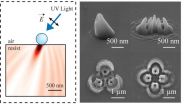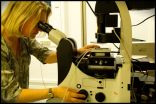INFORMATION:
The work has opened up a lot of questions in figuring out why people mount different types of responses, and potentially how the seasonal vaccine may play a role in boosting these responses, Thomas said. He has started additional studies in other groups of people with varied vaccination and infection histories to tease apart what exposures boost immunity against avian influenza viruses.
The study was supported by the National Institutes of Health Centers of Excellence for Influenza Research and Surveillance (St. Jude CEIRS, contract HHSN272201400006C) and the American Lebanese Syrian Associated Charities (ALSAC), a fund-raising organization for the hospital. The article can be found online at [URL to come].
mBio is an open access online journal published by the American Society for Microbiology to make microbiology research broadly accessible. The focus of the journal is on rapid publication of cutting-edge research spanning the entire spectrum of microbiology and related fields. It can be found online at http://mbio.asm.org.
The American Society for Microbiology is the largest single life science society, composed of over 39,000 scientists and health professionals. ASM's mission is to advance the microbiological sciences as a vehicle for understanding life processes and to apply and communicate this knowledge for the improvement of health and environmental and economic well-being worldwide.
Seasonal flu vaccines boost immunity to many types of flu viruses
2014-12-08
(Press-News.org) WASHINGTON, DC - December 9, 2014 - Seasonal flu vaccines may protect individuals not only against the strains of flu they contain but also against many additional types, according to a study published this week in mBio®, the online open-access journal of the American Society for Microbiology.
The work, directed by researchers at St. Jude Children's Research Hospital in Memphis, Tenn., found that some study participants who reported receiving flu vaccines had a strong immune response not only against the seasonal H3N2 flu strain from 2010, when blood samples were collected for analysis, but also against flu subtypes never included in any vaccine formulation.
The finding is exciting "because it suggests that the seasonal flu vaccine boosts antibody responses and may provide some measure of protection against a new pandemic strain that could emerge from the avian population," said senior study author Paul G. Thomas, PhD, an Associate Member in the Department of Immunology at St. Jude. "There might be a broader extent of reactions than we expected in the normal human population to some of these rare viral variants."
Because avian influenza viruses have an important role in emerging infections, Thomas and colleagues tested whether exposure to different types of birds can elicit immune responses to avian influenza viruses in humans. They studied blood samples taken from 95 bird scientists attending the 2010 annual meeting of the American Ornithologist Union. They exposed plasma from the samples to purified proteins of avian influenza virus H3, H4, H5, H6, H7, H8 and H12 subtypes using two laboratory tests to see how many different viruses participants reacted to, and how strongly. The first test, ELISA, measures if any antibodies -- proteins produced by the body that are used by the immune system to identify and neutralize foreign objects such as bacteria and viruses - combine in any way to a protein called HA on the surface of the virus. The second, HAI, measures if antibodies can bind to HA and interrupt its association with a substance viruses use to get inside human cells.
In the ELISA tests, 77 percent of participants had detectable antibodies against avian influenza proteins. Most individuals tested had a strong antibody response to the seasonal H3N2 human virus-derived H3 subtype, part of that year's vaccine (2009-2010), but many also had strong measurable antibody responses to group 1 HA (avian H5, H6, H8, H12) and group 2 HA (avian H4, human H7) subtypes. Sixty-six percent of participants had some level of detectable antibodies against four or more HA proteins, and a few had responses to all subtypes tested, most of which have not previously been detected in the human population.
In additional experiments, the scientists found that participants who had significant antibody responses did not necessarily also have significant immune system T cell responses to avian viruses, indicating that these two arms of immunity can be independently boosted after vaccination or infection; that individuals who reported receiving seasonal influenza vaccination had significantly higher antibodies to the avian H4, H5, H6, and H8 subtypes; and that participants with exposure to poultry had significantly higher antibody responses to the H7 subtype, but to none of the other subtypes tested. Exposure to other types of birds did not play a role in immunity.
A person's immune response on the ELISA test did not necessarily predict response on the HAI test, and vice versa. As HAI antibodies only target the "head" of the HA while ELISA antibodies can be against the head or the relatively conserved "stalk" domain, this result indicated that some individuals were more likely to target the conserved stalk region (i.e. show greater reactivity in ELISA than in HAI).
ELSE PRESS RELEASES FROM THIS DATE:
San Francisco public housing type a strong predictor of kids' use of emergency rooms
2014-12-08
San Francisco children living in non-redeveloped public housing are 39 percent more likely to repeatedly visit emergency rooms, according to new research from UC San Francisco and UC Berkeley.
"The average emergency department (ED) visit costs two to five times more than an office visit, and many children visit EDs for potentially preventable reasons," said Nancy Adler, PhD, senior author of the research, and vice chair of the department of psychiatry and director of the Center for Health and Community at UCSF. "There is a clear need to better understand the range of ...
New research shows fewer deaths related to RSV than previously thought
2014-12-08
(SALT LAKE CITY)- It's a virus that has long been characterized as dangerous and even deadly, but new research shows infant deaths from respiratory syncytial virus (RSV) are actually quite uncommon in the 21st century.
Researchers at the University of Utah have shown there are approximately 42 deaths annually associated with RSV in the United States, and of those deaths, the majority are in infants and young children that have complex preexisting chronic conditions.
"The news is very good for parents and their babies," says Carrie Byington, M.D., professor of pediatrics ...
High photosensitivity 2D-few-layered molybdenum diselenide phototransistors
2014-12-08
Two-dimensional (2D) layered materials are now attracting a lot of interest due to their unique optoelectronic properties at atomic thicknesses. Among them, graphene has been mostly investigated, but the zero-gap nature of graphene limits its practical applications. Therefore, 2D layered materials with intrinsic band gaps such as MoS2, MoSe2, and MoTe2 are of interest as promising candidates for ultrathin and high-performance optoelectronic devices.
Here, Pil Ju Ko and colleagues at Toyohashi University of Technology, Japan have fabricated back-gated field-effect phototransistors ...
Vitamin C may help people who suffer from respiratory symptoms after exercise
2014-12-08
Physical activity increases oxidative stress, and therefore, as an antioxidant vitamin C might have particularly evident effects on people who are participating in vigorous exercise. In several studies, vitamin C administration attenuated the increases in oxidative stress markers caused by exercise. Furthermore, vitamin C is involved in the metabolism of histamine, prostaglandins, and cysteinyl leukotrienes, all of which appear to be mediators in the pathogenesis of exercise-induced bronchoconstriction.
A meta-analysis of three studies found that vitamin C halved post-exercise ...
Confounding factors contribute to unexpected results of trial of renal denervation
2014-12-08
A new analysis of an important trial of the blood pressure-lowering procedure, renal denervation, shows that the main results may have been affected by a number of confounding factors that partially explain the unexpected blood pressure responses in patients.
The analysis, published in the European Heart Journal [1], identified factors in the SYMPLICITY HTN-3 trial, such as variations in the way the procedure was performed and changes in patients' medications and drug adherence, which may have had a significant impact on the results.
Results of the SYMPLICITY HTN-3 ...
X-ray laser acts as tool to track life's chemistry
2014-12-08
An international research team that includes researchers from Lawrence Livermore National Laboratory has captured the highest-resolution protein snapshots ever taken with an X-ray laser, revealing how a key protein in a photosynthetic bacterium changes shape when hit by light.
Human biology is a massive collection of chemical reactions and all involve proteins, known as the molecules of life. Scientists have been moving steadily toward their ultimate goal of following these life-essential reactions step by step in real time, at the scale of atoms and electrons.
"These ...
Novel strategies direct immune system to attack recurrent, hard-to-treat blood cancers
2014-12-08
(SAN FRANCISCO, December 6, 2014) - Novel treatments that harness the body's own immune cells to attack cancer cells demonstrate safe and durable responses in patients with relapsed and treatment-resistant blood cancers, according to data presented today at the 56th American Society of Hematology (ASH) Annual Meeting and Exposition.
Therapies designed to target the immune system and ignite the body's own disease-fighting mechanisms have become an increasingly promising field of study, particularly in blood cancers. While the immune system can easily recognize viruses ...
New technique allows low-cost creation of 3-D nanostructures
2014-12-08
Researchers from North Carolina State University have developed a new lithography technique that uses nanoscale spheres to create three-dimensional (3-D) structures with biomedical, electronic and photonic applications. The new technique is significantly less expensive than conventional methods and does not rely on stacking two-dimensional (2-D) patterns to create 3-D structures.
"Our approach reduces the cost of nanolithography to the point where it could be done in your garage," says Dr. Chih-Hao Chang, an assistant professor of mechanical and aerospace engineering ...
Cell division induces tissue ordering
2014-12-08
Nature's ingenious systems: A layer of cells called endothelial cells lines the interior of blood vessels. When blood flows through the vessels, such cells only divide to replace dead cells. However, if there is a blood clot preventing blood from flowing across the endothelial cells, they begin to divide more actively. New research from the Niels Bohr Institute demonstrates that cell division is very ordered. The new cells move away from each other and create a dynamic movement with eddies in a large area. This presumably helps to widen the vessel around the blockage. The ...
Study finds early warning signals of abrupt climate change
2014-12-08
A new study by researchers at the University of Exeter has found early warning signals of a reorganisation of the Atlantic oceans' circulation which could have a profound impact on the global climate system.
The research, published today in the journal Nature Communications, used a simulation from a highly complex model to analyse the Atlantic Meridional Overturning Circulation (AMOC), an important component of the Earth's climate system.
It showed that early warning signals are present up to 250 years before it collapses, suggesting that scientists could monitor ...


